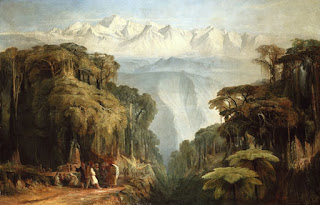In the Indian subcontinent cattle herding (mainly
cow/ buffalo/ sheep/ goat/ yak) has been popular and rivers have been the life line
for the herders. Herding is such an important livelihood and culture that Lord
Krishna has been depicted as a herder, who spent a major part of his youth
beside River Jamuna. Agriculture comparatively has been attached with less
glamour and was put on to his brother Balaram (often referred to as Haladhar,
the bearer of the plough). As we culture the life and legends of Lord Krishna,
we will come across thousands of stories through religious talks, songs and
descriptions of the herding life of the Great God, who is the reincarnation of
Lord Vishnu in Hinduism.
Teesta has been no exception. The lower stretches of Teesta
(in the plains) and also the areas of River Brahmaputra were known for their
‘BATHANS’. The herders had to camp in the river islands, often far away from
their home. In isolation, a small group of herders reared their cattle and made
all possible products from their milk. They came back home to their families
for a small period in the monsoons, when there was enough fodder for the cattle
in the village and also that the river island would have drowned. Some of them
were days away and some just a day out. It was always the more daring,
exploring and bohemian youths of the village who would take to herding and the
entire village or landlord or king would leave their cattle to them. There were
all kinds of stories which built up with the herders during their journeys; adventurous,
legendary, sad, romantic and happy. They had their own stories from the
grazing/pasture lands. They were talented with their song and music, many of
them which they composed and many more which they collected from faraway lands.
Even the village had their own songs and music for them on their arrivals and
mainly departures. A whole school of song and music grew up around them, often
referred to as Goalparia and Bhawaiya in the Teesta and Brahmaputra plains, the
songs of the ‘Mahishal’ and many more.
The present situation is fast changing, the pastures are
becoming permanent human habitat, some develop into forests being designated as
state or central Government Protected Areas which are often out of bounds for
adjoining villagers, the present situation do not allow the herders to venture
faraway, they prefer to day herding from their villages. During my visit beyond
Mekhliganj, the last border post of the BSF towards Neelphamari-Bangladesh,
there are a few villages and in the river is the ‘Charland’ (river island),
where again there is a BSF post now (a well established security system which
has stopped crossing over across the borders). The herders from Bangladesh used
to frequent this area in the recent past for the good quality fodder grass for
their cattle. Now this is exclusively daily used by the herders from Raipara.
Every morning the herding lot of the village get their cattle counted by the
BSF men and return with the same before sunset. Most of the residents of this
village have lost their fertile agriculture lands in the River Teesta, some of
them still continue to be herders, swimming to the grasslands in the river
islands everyday with their cattle. 52 years Dinesh Rai, one of the most
elderly herders, who has about 07 cows of his own, but herds the cows of his
neighbours on a verbal contract basis along with 35 years old Shibkumar Rai and
a handful of still younger herders herds about a hundred animals every day,
simply by swimming across the river. They cross miles in the river with these
animals. This is an unbelievable sight for anyone to witness.
They all have a hard life. Other youths whose families have
lost their agriculture lands in the River and many who cannot take the
challenge of herding have migrated to nearby urban areas, mostly to Siliguri as
rickshaw pullers, carpenter helpers etc, and are seen to be economically doing
better than their adventurous and enterprising counterparts in the village. The
livelihood and romance of herders still continue, the songs are still sung and
Teesta is still prayed and respected as the Teesta Buri (The eternal mother) of
the Teesta communities.
The story of the Teesta herders are not only in the lower
stretches, but also in the high Himalaya, the areas which form the headwaters
also witness the culture of the herders, here they are known as ‘GOTH’ and the
herders as ‘GOTHALA’, very respected in the Himalayan society. In these
highlands it is mostly the yak and sheep. Again the borders and the
imperialistic forest and wildlife management institutions are bringing about a
slow death to this culture. Most of the trade routes of the past were based on
these herding trails, many of which are today trek routes of tourism
importance. At Mangan, the headquarters of North Sikkim the legend of the 16
year old Lakpa Lepcha warms the place.
Gurung Daju, the famous herder from Naga village has adopted
the 02 years old Lakpa and carried him along the ‘Gothala Route’, a route which
is followed in the high Himalaya depending on the season, snow and available
fodder with few camps along the route. The Gothala Route from Mangan starts
from the nearest camp at Gurung Daju’s village, Naga Gumpha, Naga Tar, Kukhre
Orale, Borsardam, Toshar Lake. Lakpa Lepcha, who has inherited this route, at
16 years he sometimes is all alone with the animals. He has this magical power
of getting together his yaks with his songs. Lakpa tells the stories of the
flowering valleys of July-August, the snow fairies of November and the water
Goddess of April. All herders along the Teesta River have their experiences
with Nature God, the emotion of born traveller and the spirit of the true adventurer.





No comments:
Post a Comment